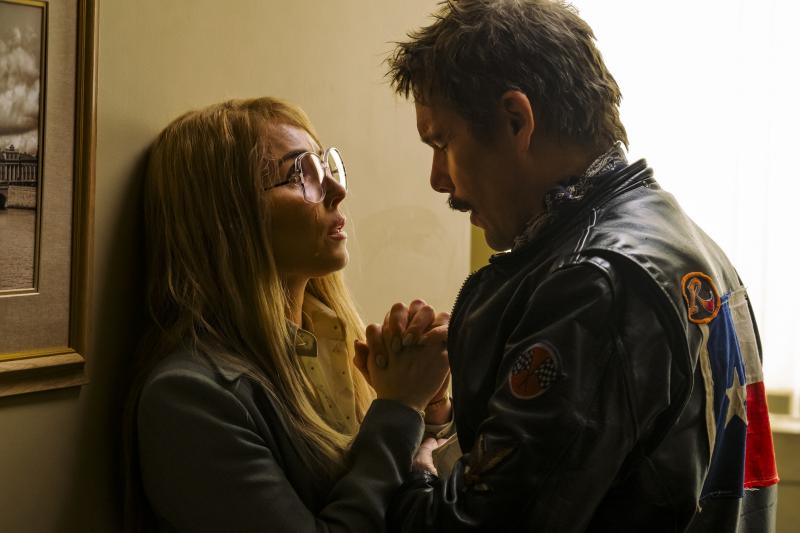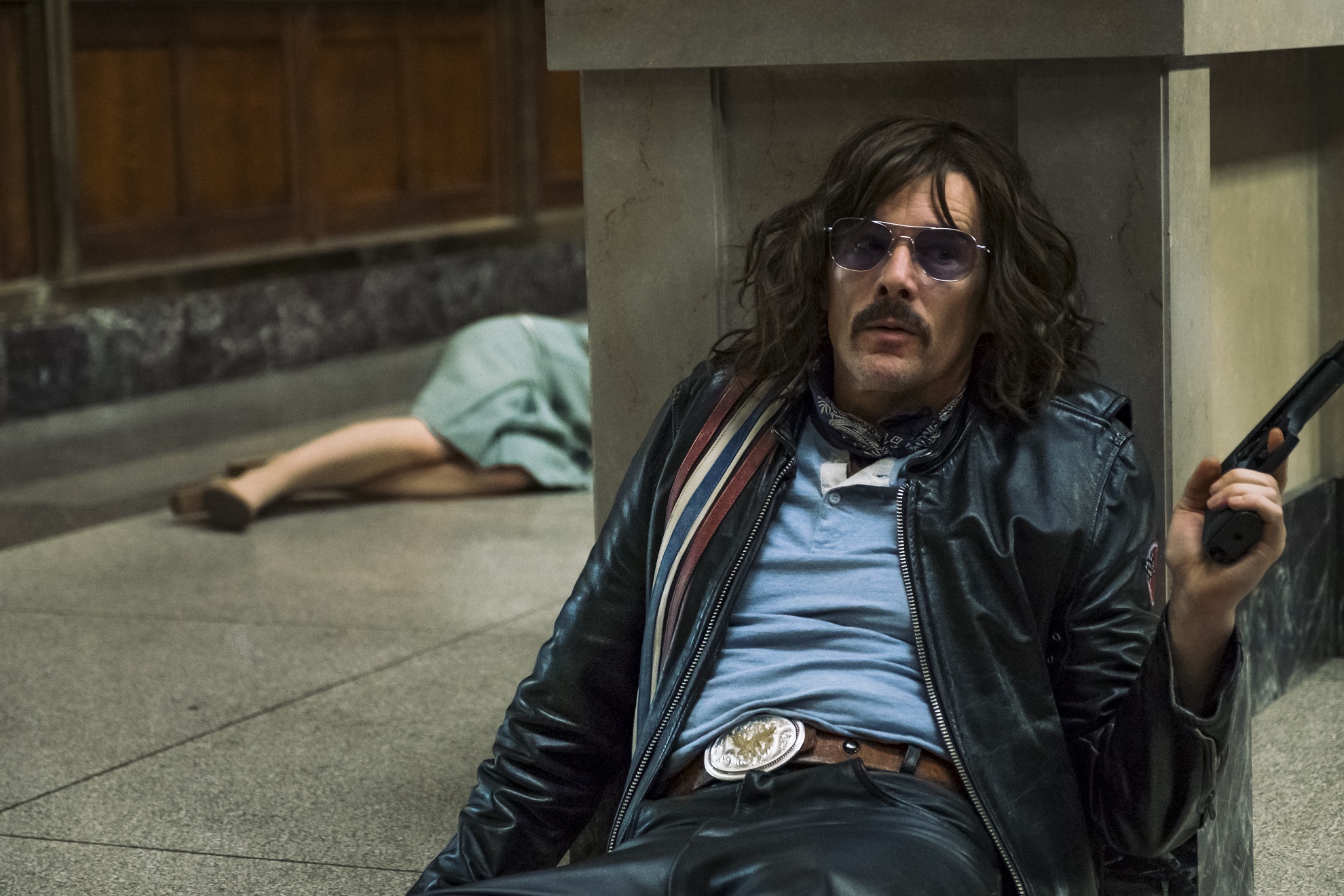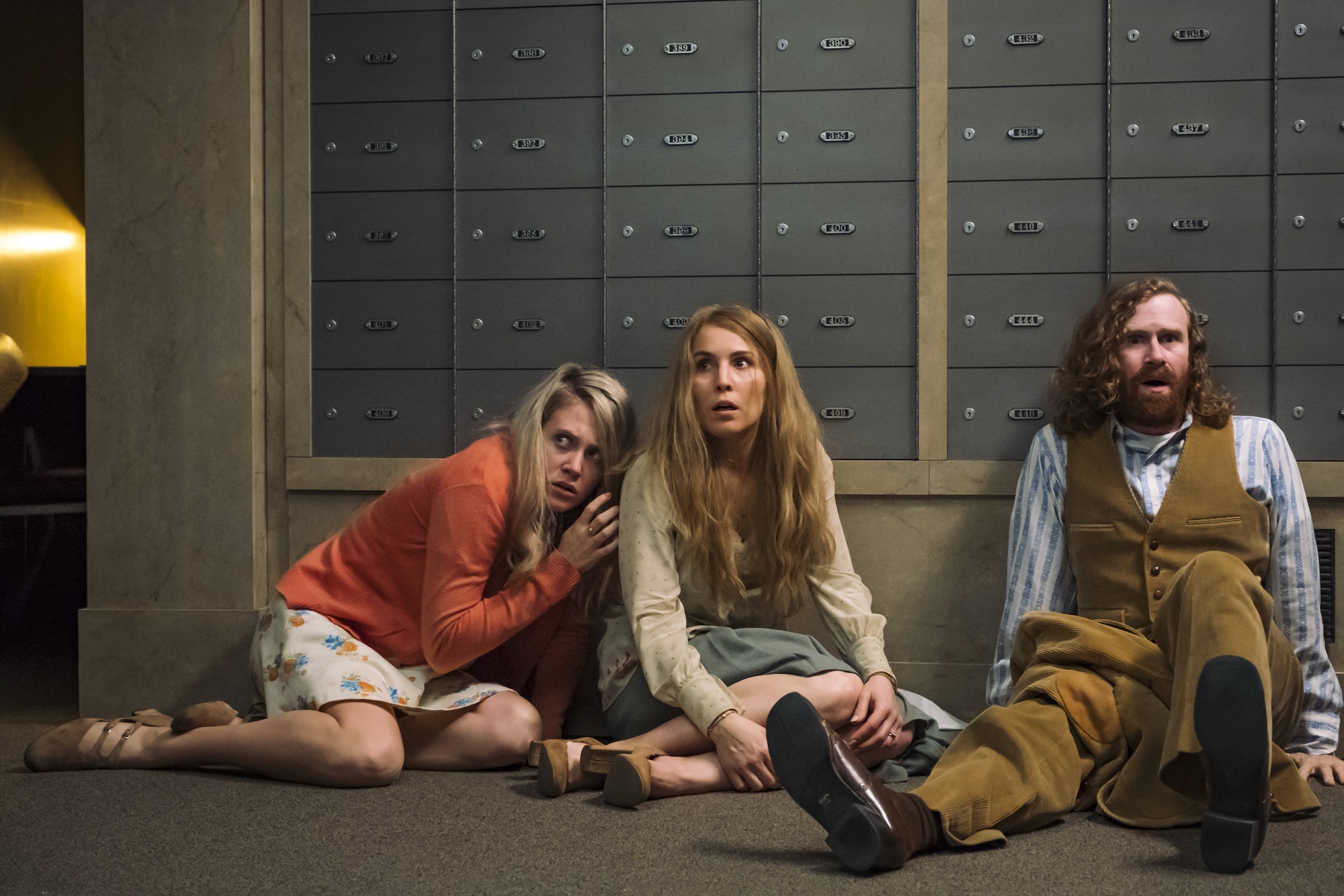The Captor review - Stockholm syndrome silliness | reviews, news & interviews
The Captor review - Stockholm syndrome silliness
The Captor review - Stockholm syndrome silliness
Farcical hostage crisis rescued by Rapace

The botched 1973 hostage incident which inspired the term Stockholm syndrome comes to flatly comic life here, the strange psychological phenomenon of captives falling for their captors over time being reduced to an absurd caper.
Lars takes over a Stockholm bank one sunny morning, in a city here parodically pastel-coloured and post-hippie, with the radio dial agreeably set to Dylan in his country-rock phase (the real-life hostage-taker’s taste ran more to Roberta Flack, singing “Killing Me Softly” incessantly as the crisis unfolded).
Rapace shows why even Rooney Mara couldn’t replace her as Lisbeth Salander, suggesting spooked intelligence jangling behind Bianca’s librarian glasses. For both Lars’ female captives, terror gives way to a taste of forbidden life. As Bianca’s fellow bank teller, Bea Santos (pictured bottom left with Rapace and Mark Rendall) almost wordlessly blooms with the thrill of it.
 Though writer-director Robert Budreau struggles to find a feminist angle in a woman being tied up by an unreliable man with a gun, Rapace’s clear superiority to Hawke’s dimwit leaves her running the show by the end, growing to prefer this strange captivity to dull married life. The moment where they start to make love brings a mutual peace truer than anything else in a mostly silly film, the dangerous limbo they’ve both stumbled into momentarily complete.
Though writer-director Robert Budreau struggles to find a feminist angle in a woman being tied up by an unreliable man with a gun, Rapace’s clear superiority to Hawke’s dimwit leaves her running the show by the end, growing to prefer this strange captivity to dull married life. The moment where they start to make love brings a mutual peace truer than anything else in a mostly silly film, the dangerous limbo they’ve both stumbled into momentarily complete.
Budreau attempts a wider social context. Sweden’s Prime Minister, Olaf Palme (Shanti Roney), watches Nixon trying to bluff his way out of Watergate on TV as he fumbles his own response to Lars’ highly public demands. The police, meanwhile, are pompous, repressed dullards in incongruously colourful threads, led by a Police Chief (Christopher Heyerdahl) so stiff-backed you fear he may snap. Does the hostage-taking reveal wider fault-lines in Swedish society? Budreau can’t say. The period setting is mostly a matter for the costume department, primarily its wig division.
 Even when Lars’ more ruthless old prison pal Gunnar (Mark Strong) is released from jail to join him in his barely superior cage in the armed police-blanketed bank, these career criminals are presented as essentially harmless buffoons compared to the cops outside. Puffed up by his initial success, Lars asks to be called “the Outlaw”, and wants the car Steve McQueen used in Bullitt for his getaway. Butch Cassidy and the Sundance Kid is jovially mentioned too. Falling prey to his own Stockholm syndrome, Budreau lets his crooks off their dangerous foolishness.
Even when Lars’ more ruthless old prison pal Gunnar (Mark Strong) is released from jail to join him in his barely superior cage in the armed police-blanketed bank, these career criminals are presented as essentially harmless buffoons compared to the cops outside. Puffed up by his initial success, Lars asks to be called “the Outlaw”, and wants the car Steve McQueen used in Bullitt for his getaway. Butch Cassidy and the Sundance Kid is jovially mentioned too. Falling prey to his own Stockholm syndrome, Budreau lets his crooks off their dangerous foolishness.
In a micro-genre which also includes the funny but sweatily tragic Dog Day Afternoon, this is a wasted opportunity, filmed without imagination. Written and played, too, as if the story being told is inconsequential, it’s hard to care about anyone except the mysterious Rapace.
The future of Arts Journalism
You can stop theartsdesk.com closing!
We urgently need financing to survive. Our fundraising drive has thus far raised £49,000 but we need to reach £100,000 or we will be forced to close. Please contribute here: https://gofund.me/c3f6033d
And if you can forward this information to anyone who might assist, we’d be grateful.

Subscribe to theartsdesk.com
Thank you for continuing to read our work on theartsdesk.com. For unlimited access to every article in its entirety, including our archive of more than 15,000 pieces, we're asking for £5 per month or £40 per year. We feel it's a very good deal, and hope you do too.
To take a subscription now simply click here.
And if you're looking for that extra gift for a friend or family member, why not treat them to a theartsdesk.com gift subscription?
more Film
 The Mastermind review - another slim but nourishing slice of Americana from Kelly Reichardt
Josh O'Connor is perfect casting as a cocky middle-class American adrift in the 1970s
The Mastermind review - another slim but nourishing slice of Americana from Kelly Reichardt
Josh O'Connor is perfect casting as a cocky middle-class American adrift in the 1970s
 The Perfect Neighbor, Netflix review - Florida found-footage documentary is a harrowing watch
Sundance winner chronicles a death that should have been prevented
The Perfect Neighbor, Netflix review - Florida found-footage documentary is a harrowing watch
Sundance winner chronicles a death that should have been prevented
 Blu-ray: Le Quai des Brumes
Love twinkles in the gloom of Marcel Carné’s fogbound French poetic realist classic
Blu-ray: Le Quai des Brumes
Love twinkles in the gloom of Marcel Carné’s fogbound French poetic realist classic
 Frankenstein review - the Prometheus of the charnel house
Guillermo del Toro is fitfully inspired, but often lost in long-held ambitions
Frankenstein review - the Prometheus of the charnel house
Guillermo del Toro is fitfully inspired, but often lost in long-held ambitions
 London Film Festival 2025 - a Korean masterclass in black comedy and a Camus classic effectively realised
New films from Park Chan-wook, Gianfranco Rosi, François Ozon, Ildikó Enyedi and more
London Film Festival 2025 - a Korean masterclass in black comedy and a Camus classic effectively realised
New films from Park Chan-wook, Gianfranco Rosi, François Ozon, Ildikó Enyedi and more
 After the Hunt review - muddled #MeToo provocation
Julia Roberts excels despite misfiring drama
After the Hunt review - muddled #MeToo provocation
Julia Roberts excels despite misfiring drama
 London Film Festival 2025 - Bradley Cooper channels John Bishop, the Boss goes to Nebraska, and a French pandemic
... not to mention Kristen Stewart's directing debut and a punchy prison drama
London Film Festival 2025 - Bradley Cooper channels John Bishop, the Boss goes to Nebraska, and a French pandemic
... not to mention Kristen Stewart's directing debut and a punchy prison drama
 Ballad of a Small Player review - Colin Farrell's all in as a gambler down on his luck
Conclave director Edward Berger swaps the Vatican for Asia's sin city
Ballad of a Small Player review - Colin Farrell's all in as a gambler down on his luck
Conclave director Edward Berger swaps the Vatican for Asia's sin city
 London Film Festival 2025 - from paranoia in Brazil and Iran, to light relief in New York and Tuscany
'Jay Kelly' disappoints, 'It Was Just an Accident' doesn't
London Film Festival 2025 - from paranoia in Brazil and Iran, to light relief in New York and Tuscany
'Jay Kelly' disappoints, 'It Was Just an Accident' doesn't
 Iron Ladies review - working-class heroines of the Miners' Strike
Documentary salutes the staunch women who fought Thatcher's pit closures
Iron Ladies review - working-class heroines of the Miners' Strike
Documentary salutes the staunch women who fought Thatcher's pit closures
 Blu-ray: The Man in the White Suit
Ealing Studios' prescient black comedy, as sharp as ever
Blu-ray: The Man in the White Suit
Ealing Studios' prescient black comedy, as sharp as ever
 The Woman in Cabin 10 review - Scandi noir meets Agatha Christie on a superyacht
Reason goes overboard on a seagoing mystery thriller
The Woman in Cabin 10 review - Scandi noir meets Agatha Christie on a superyacht
Reason goes overboard on a seagoing mystery thriller

Add comment